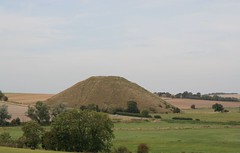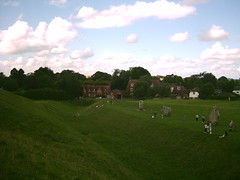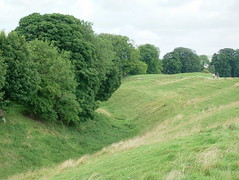
Mystical Avebury . . .
Although I grew up in Wessex, I never visited Avebury until about 10 years ago, after a friend had mentioned walking round it one New Year. It was just the wrong side of Salisbury Plain for me, especially as I tended to go looking for the antiquities of Dorset rather than Wiltshire. So the next time we were heading for Hampshire, we went via Avebury. WOW! Archaeology is one of my passions. I saw pictures of Avebury in lectures at Uni. I included it in essays about stone circles, but until I went there, I really didn't know quite how amazing a place it is. It is so vast, that there is a whole village inside it. Truly - THAT big. There are massive ditches and ramparts surrounding the vast sarsen stones, which were dragged, rollered, removed somehow from the chalk downlands above Avebury and somehow engineered into place. It has an amazing atmosphere and to me, makes Stonehenge look like a Lego newbuild . . . The photo below gives you an idea of what the chalk downland looks like.

Avebury does not exist on its own as a monument. It is part of a ritual landscape, which includes Silbury Hill, which was built in the Neolithic. As a child I heard it said that there was a king on a golden horse buried at the bottom of it. Subsequent archaeological digs have proved this was never the case, sadly. However, it is the largest man-made mound in Europe and archaeologists have worked out that it would have taken 800 men ten years to complete - that would be working the year round.

For miles around, there are many barrows where the important people of the Neolithic and Bronze Age were buried. We have visited West Kennet Long barrow many times, with its huge blocking stones and extended barrow, perhaps a hundred feed long. It must have been a potent marker, perhaps a territorial one, when it was first built and pure white, like the Avebury ditches. It is of a type called Severn-Cotswold, a 'transepted gallery-grave' and was in use from 3700 BC (the early Neolithic) to 2200 BC, when it was sealed. The bones of some 46 individuals were found interred, and the older bones were carefully tidied before a new person was interred. The different chambers were used for children and juveniles together; male adult burials; old people; and mixed male and female bones. Here is a view from inside:
 Close to Avebury are processional ways - stone rows to be exact - of smaller stones, called Beckhampton Avenue and West Kennet Avenue. The latter is the best-preserved avenue in central Southern England.
Close to Avebury are processional ways - stone rows to be exact - of smaller stones, called Beckhampton Avenue and West Kennet Avenue. The latter is the best-preserved avenue in central Southern England.Contemporary with the construction and ritual use of Avebury was a ritual site called The Sanctuary, by William Stukely, an antiquarian in the early 18th century. Concrete bollards now mark the sites of post holes in concentric rings. It is believed to be a series of roofed circular buildings dating to about 3000 BC and renewed subsequently.
Here is a good view of the profile of the bank and ditch. When Avebury was first constructed, the ditch would not have silted up like this of course, and would have been glaringly white. That would truly have added to the WOW factor.

You need figures close to the stones to give you a true idea of the enormous size of many of them, but perhaps this picture conveys a little of their stature.

Houses are built close by and in the past some of the stones were broken up and incorporated into the buildings themselves.

The figures walking along the top of the bank helps convey the scale of the bank and ditch.

Many books have been written about the stones, one of them claiming that the stones are meant to represent male and female persona. The jury is still out on this one! I think it's the stone with a blow hole in it - on one visit there was a young woman blowing into a hole in one of the stones.

Concrete bollards now replace and mark where sarsens once stood. One or two other stones have been pieced back together after being broken up in past centuries. During renovation of the circle in the 1930s, one of the stones was found to have a skeleton beneath it. It was believed to be the body of a barber-surgeon because a pair of scissors and a medical probe being found with the body. A coin dated his death to the 14th century.

It is a truly amazing place with a wonderful atmosphere. It is still serving the people today - visitors, tourists, New Agers, Dowsers - you can even get married there I believe. If you've never been there - do try and visit . . .
This excellent site will give further photographs and tell you more about Avebury's history:
www.new-age.co.uk/avebury-stones.htm


5 comments:
That is some fascinating history...I love learning about things like that. The pictures are wonderful and I'd love to visit someday! Can I come over for tea too? :0)
Hugs,
Kelli
Jennie,
What an amazing place. I have never before heard of a stone circle big enough to have a village inside. And the ditches - man-made? Thinking of that and the mound which involved such intense labor, it makes me wonder what kind of motivation it takes to produce that kind of dedication. I guess nothing is known about that aspect.
Thanks again, my friend.
Nancy
Kettle's on Kelli! It is a truly amazing place. If you Google Avebury you will find lots of links and get overhead photos which show the village in relation to the vast stone circle.
Nancy - what's more, the ditches were dug out just using antler picks . . . Hard to imagine the work which went into it, but a very strong belief and a very strong leader caused this to happen. These HUGE stones, were dragged from miles away too . . .
Glad you enjoyed learning about it. As I said, it knocks Stonehenge into a cocked hat!
Jennie, I went back and Googled it. There are some pretty amazing photos. Yeah, not to mention moving the stones themselves. How intriguing!
Nancy
Thank you for that, BB, Avebury is one of my favorite places in all the World. The magic just tingles in the air. It's a fabulous place :)
Kim
Post a Comment